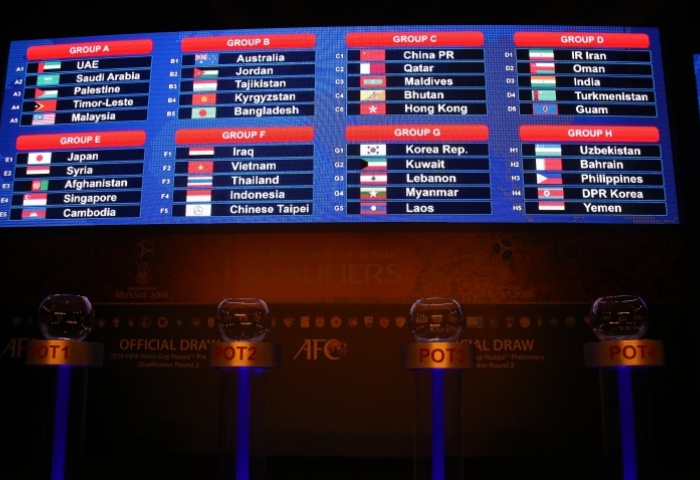Following last Tuesday’s draw for the AFC’s World Cup qualification second round, we now know that China’s long road to Russia will begin in Thimpu, Bhutan on June 16th and that if you combined the surface area of all four of China’s opponents it would still only be half the size of Jiangsu Province.
Despite that apparent disparity, several fascinating clashes await the Guozu as they seek to advance from a five team group also featuring Qatar, the Maldives and Hong Kong. With only the group winner guaranteed progression to the third and final round of qualifying, Qatar clearly provide the sternest test in a fixture list which looks very negotiable on paper.
Double Dragon…
China’s trip to the Himalayan Kingdom is sure to draw international media coverage as the Bhutanese side captured the world’s imagination with their two-legged victory over Sri Lanka in the first round of qualifying. It was an inspirational win for a team that was, at that point, considered the worst in the world and there will no doubt be many neutrals around the globe supporting Bhutan in what is a true David vs Goliath clash.
However, while everyone loves a fairy tale, it’s not as much fun when it happens at your expense. Anything less than a convincing win for the Chinese will be seen as a serious blip for Alain Perrin’s men. With Thimpu lying 2,320 metres above sea level, altitude may be a factor, but that can’t be an excuse against a country with a population of less than 1 million which, until this March, hadn’t won a football game since 2008.
An internal affair…
On September 3rd attention turns much closer to home when Hong Kong make the short trip to the mainland. In footballing terms, the game is unlikely to set pulses racing, but recent political issues and anti-mainland Chinese sentiment in the metropolis give this clash an added edge.
Depending on political developments between now and then, the return fixture in Hong Kong on November 17th could provide a potential flash point as well as offering up a possible banana skin for Guozu. Older fans still remember China’s elimination from the 1986 World Cup qualifiers at the hands of what was then still the British colony of Hong Kong, although that looks far less probable this time around.
Hopefully not too much trouble in paradise…
After playing host to Hong Kong, the national team is then likely to find itself surrounded by wealthy honeymooners as it flies to Male for a clash with the Maldives on September 8th. Many still associate the Maldives with the side which “burst” onto the international scene during their maiden World Cup qualifying campaign for France 98. That team managed to concede 59 goals in six matches, including two 12-0 spankings from Syria and a 17-0 humiliation at the hands of Iran.
The Red Snappers have greatly improved since then and have even been doing some humiliating of their own in recent years with a 7-1 win over Laos and a 10-0 demolition of Sri Lanka demonstrating how far they’ve come. However, the island chain with a population of less than 400,000 remains a footballing minnow who should be comfortably swept aside. That being said, China can not take them too lightly, meaning that there may not be much time for chilling in a luxury beach bungalow during pre-match preparations.
Familiar foes…
There is no chance of anybody taking China’s trip to Qatar on October 8th lightly, least of all Alain Perrin. Before taking over the Chinese national team, the Frenchman had spent four years coaching in the Gulf state – managing three separate clubs either side of a spell in charge of the under-23 national side.
Reacting to the draw, the former Portsmouth manager was quoted as saying “They are a side which I don’t want to be drawn against. I am familiar with their football. I think the Qataris are the strongest among the second seeds.”
Perrin’s anxiety is supported by a recent history which has seen these two sides face each other in four of the last seven World Cup qualifying campaigns. Back in 1989, the Maroon came out on top in a dead rubber match after both sides had already been knocked out of contention for Italia 90 but, eight years later, a 3-2 victory for the Qataris in Dalian led to the Chinese finishing one point shy of a play-off for a spot at France 98.
Four years later, China got their revenge as they took four points off Qatar while streaking to a place in Korea/Japan. However, that outcome was reversed on the road to South Africa 2010 as China managed just one draw in two matches with the Qataris on their way to being eliminated before the final round. The most recent meeting between these sides was in the 2011 Asian Cup where a 2-0 win for Qatar led to them advancing to the quarter-finals at China’s expense.
A lot has changed since then, and that was illustrated at the most recent Asian Cup where China blasted through the group stages with three wins from three, while Qatar were consigned to a trio of disappointing defeats at the hands of the UAE, Iran and Bahrain. A win in Doha will not be easy, but this current Chinese side should be good enough to leave the Middle East with at least a point. Should they do that, and avoid slipping up in their three subsequent matches – Bhutan (home, Nov. 12th), Hong Kong (away, Nov 19th) and Maldives (home, Mar 24th 2016) – the stage will be set for a final showdown with the Qataris in China on March 29th 2016.
Looking further ahead…
With the four best runners-up out of the eight groups also advancing to the third round of qualification, the comparative weakness of the other three teams means that China still have a good shot at advancing even if they fail to beat Qatar and finish just below them. The problem is, an inability to beat a second rate Asian team at home will go someway towards proving what many already fear – China will make it through this round, but will be well off the pace in the third phase of qualifying when they will have to face the likes of Japan, South Korea, Australia and Iran.
But lets leave pessimism to one side for now. Despite a couple of uninspiring recent friendly draws, China come into this qualifying campaign on a continental high. It’s almost a year between now and that final game against Qatar and so, of course, a lot can change in that time. However, at present, there is every reason to believe that China will make it through to the next stage of qualification (an achievement which will also give them a berth in the 2019 Asian Cup in the UAE) and it’s quite possible they will continue to show serious signs of improvement during that time. Should that happen, a potential six team group featuring Japan, Australia, UAE, Iraq and Saudi Arabia, for example, might not be as daunting.
Only the most fervent optimist would foresee China being at Russia in 2018 but, should they make it to the final stage, and put on a competitive showing while there, a solid foundation will be laid for the more realistic target of getting back to Qatar for the 2022 World Cup.
Try and enjoy the moment…
Whatever the long term future, the good thing is that the next year of Chinese international football offers up plenty to capture the interest including fairy tales in Himalayan Kingdoms; a local derby with against a backdrop of political tension; the potential for some one-sided hammerings or major(ly painful) upsets; and a chance to avenge previous World Cup qualifying eliminations. Given the possibilities, it’s hard to imagine a much more interesting draw.




